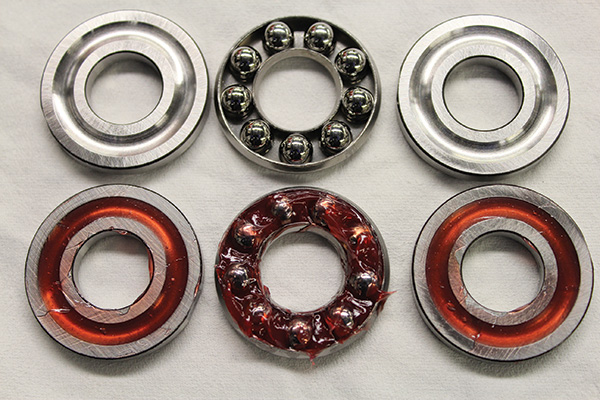
The much-anticipated High Performance Multiuse grease specification from the United States-based National Lubricating Grease Institute will make its debut in January.
The spec will provide an updated baseline for grease performance—an area that, despite significant evolution in application hardware, hasn’t seen an update since the institute’s GC-LB specification was created 30 years ago.
But this shiny new set of product performance benchmarks will enter the marketplace with provisional licensing for the ASTM D4170 fretting wear test, required for the High Load subcategory certification. Those who follow engine oil specifications are likely familiar with the concept: Rather than waiting around for a test to become available, formulators and marketers can obtain a provisional license, then undergo the tardy test once it becomes available.
Also known as the Fafnir fretting wear test, ASTM D4170 has produced unacceptably large variability in test results, especially in the past few years, said Rajeev Kumar, a research associate with ExxonMobil. This led NLGI to delay inclusion of the test for HPM+HL certification until ASTM International is able to address the problem.
A study that Kumar conducted along with Senior Research Associate Chris Decker and Joe Kaperick, senior advisor for grease technology with Afton Chemical Corp., points to changes in the bearings used for the test as the likely culprit.
Speaking during NLGI’s virtual Technical Week in late August, Kumar explained that fretting damage is caused by “contacting surfaces experiencing slight relative reciprocating sliding motion of low amplitude.” Fretting can occur in couplings, joints and bearings in applications such as wind turbines and aircraft, he noted.
“The Fafnir test was originally put in place to measure a specific type of fretting wear seen in wheel bearings in the 1960s and 1970s,” Kaperick said. That wear was caused by vibrations as cars were transported by rail. “This is how it became part of NLGI’s GC-LB specification in 1989. Today, it is still considered a good measure of fretting wear and is one of the few recognized industry tests to measure that performance—even given the current variability of the test.”
In addition to the HPM+HL specification, the test is included in the GC-LB and General Motors LS-2 grease specifications. “So it is a critical test,” Kumar stated.
ASTM D4170 calls for two ball thrust bearings with 16 millimeter internal diameter, 35.69 mm outer diameter and nine 7.1 mm balls in each race. A gram of grease is applied to each of the bearings, which are loaded into the chuck. A spring ensures the bearings don’t move out of place. The test apparatus oscillates the bearings under a fixed load for 22 hours, and results are reported as the average mass loss of the bearing races.
|
The problem of repeatability and reproducibility seen between laboratories could be due to changes in test parts, which Kumar believes are not adequately defined.
|
A series of round robin Fafnir tests conducted between 2012 and 2019 reveals a widespread distribution of results around the average, with relative standard deviation ranging from 27% to 84%, Kumar reported. “This demonstrates historically poor precision and accuracy that may be getting worse over the last two years,” he said.
The lack of repeatability and reproducibility between laboratories could be due to changes in test parts, which Kumar believes are not adequately defined, lacking critical dimensions for both the bearing race and the cage. Variations in bearing batches seem to be connected to variations in test results. “If you change anything in the test—even if it is in the spec—if the spec is not defined properly, you will see some problems.”
In the past year or two, labs have received a new bearing design for the test from supplier Falex Corp. While both the new and old bearings met the test specifications, Kumar noted that the new bearings’ style is visually different, even though the race looks similar. Furthermore, the new races are significantly rougher than the old ones. The researchers found three old bearings to have average roughness of 0.64–0.67 microns compared to 0.72–0.76 microns in three new bearings. They’re softer, too—old races had a Rockwell Hardness of 62.4 HRC, while new ones ranged from 57.1 to 58.3.

“We have not seen any statistically significant differences between the two styles, and they may have been somewhat intermixed over the last couple years,” Kaperick told Lubes’n’Greases. “Right now, we believe that the roughness, hardness and perhaps even the curvature of the races may have more to do with the variability that we are seeing.”
In tests conducted by both ExxonMobil and Afton, conditions seemed to be more severe with the new bearings, and Kumar noted that other laboratories reported similar findings. “Variation in test parts could have contributed to variability historically seen in results,” Kumar concluded, with test conditions being more mild or severe depending on the bearings.
But the bearings may not be solely deserving of blame. Kumar also highlighted the fact that while variability is wide, data falls into discrete high, medium and low groups. This could be due to bearing differences, but also to method variation or a combination of factors.
To address the concerns, Falex is working to obtain new bearing supplies. The testing equipment supplier is also running tests with different companies to examine the amount of grease loaded into the bearing, bearing hardness and roughness, and the dimensions of the race. The company is also working to ensure a common technique among labs.

At the same time, an industry taskforce including Afton, Citgo, ExxonMobil, Falex and Lubrizol completed a round robin with the new bearing set. Testing was complete at the time of writing, but the data had not been compiled.
After the task force determines the changes necessary to reduce variability, ASTM will coordinate a larger interlaboratory study to spot any potential bias in the new bearings. Changes should be in place by June 2021, Kumar said, and the test will be back in business.
Fretting Prevention
Once the test is reinstated, grease formulations will have to be able to pass it—and ultimately be effective in real-world application.
Phosphorous-based chemistry is the most common for antiwear additives. For fretting wear, in particular, a low activation temperature for these additives seems to be important, Kumar observed.
An Afton study reported in 2008 examined five different types of phosphorous additives, all formulated to deliver 1,200 parts per million of phosphorous in the final grease. While all of the additives were effective at reducing wear in fretting and SRV tests, there was no correlation between the two test methods, Kumar said.
“When you start focusing in on additive response, all of these tests are measuring performance under different conditions,” Kaperick explained. “What’s important is to understand those conditions when trying to formulate a grease to meet target performance in a given test.
“The key to phosphorus chemistries is being able to form the glassy tribolayers that can help prevent wear under various conditions. For the Fafnir fretting test, which runs at lower temperatures than many other wear tests, one difficulty can be finding a phosphorus source that will form that layer at lower temps,” he continued.
Kumar also cautioned that changing the phosphorous in a grease formulation might affect the performance of other additives or interact with the soap matrix, having a large impact on the grease’s ability to prevent fretting wear. “There is no silver bullet,” he said. Formulators “need to dial in the right additive combination for a specific formulation.”
With that said, using a softer grease containing a lower-viscosity base oil is more important in fretting wear prevention than additives, Kumar stated. This is because oil is better than grease at preventing fretting wear, and a thinner base oil can bleed more easily from a softer grease—preferably NLGI number 00 or 1. Less mechanical stability at low shear is also helpful, he said.
The Road Ahead
“Partly due to the issues we are seeing in the industry with the Fafnir test, the current plan is to include both the Fafnir and the SRV fretting tests” in the HPM+HL specification, Kaperick said.
The SRV fretting test (ASTM D7594) is relatively new, having been published in 2010, and is recognized as being more repeatable. However, the SRV test is not as widely available as the Fafnir test, and the HPM specification development committee was initially concerned that it would be difficult for applicants to complete the testing, according to Kaperick, who is NLGI president and has been involved in the committee’s work.
“Ultimately, it was felt that the number of testing sites available in the U.S. was sufficient. No other fretting wear tests were identified during our discussion that were widely available or recognized as good measures of this performance attribute,” he said.
The industry “needs to be able to fix fretting, but also needs to measure accurately to know that it has been fixed and will correlate to the real world,” Kumar summarized. “Solving the fretting wear issues and putting the tighter specs and controlling the test itself is key, not only for the ASTM test, but also for the other specifications that are using that particular test.”
Caitlin Jacobs is managing editor of Lubes’n’Greases magazine. Contact her at Caitlin@LubesnGreases.com.